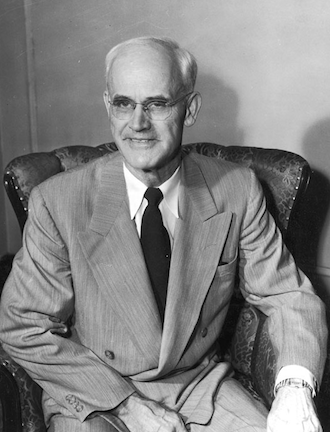Arthur V. Watkins
Arthur Vivian Watkins was a United States Senator from Utah. He served two terms from 1947 to 1959. He is best known for his service as chairman of the Senate Select Committee, which recommended the Censure of Wisconsin’s Senator Joseph McCarthy for his conduct in investigating communists in government.
He was also recognized as a reclamation authority and was instrumental in the Deer Creek Reservoir Project.
His most controversial and far-reaching position was with regards to Native Americans. He was appointed chair of the Senate Interior Committee Subcommittee on Indian Affairs in 1947. He had grown up on the fringe of the Uintah and Ouray Reservation and had been influenced by various cultural movements at the time. His belief in the heritage and prophecies for Native Americans were evident in his April 1954 letter to general authorities of the Church of Jesus Christ:
- The more I go into this Indian problem the more I am convinced that we have made some terrible mistakes in the past. It seems to me that the time has come for us to correct some of these mistakes and help the Indians stand on their own two feet and become a white and delightsome people as the Book of Mormon prophesied they would become. Of course, I realize that the Gospel of Jesus Christ will be the motivating factor, but it is difficult to teach the Gospel when they don't understand the English language and have had no training in caring for themselves. The Gospel should be a great stimulus and I am longing and praying for the time when the Indians will accept it in overwhelming numbers.
- — Arthur V. Watkins[1]
Watkins and others pursued tenets that would enable Native Americans: 1. To eliminate laws that treated Native Americans as different from other Americans; 2. To dismantle the Bureau of Indian Affairs, giving responsibility for their affairs to the tribes themselves, or if necessary transferring some of its duties to other federal and state agencies; 3. To end federal supervision of individual Indians; 4. To cease federal guardianship responsibilities for Indian tribes and their resources.[2]
However, according to Wikipedia’s sources, the policies had disastrous effect on Native peoples. “Tribes were cut off from services for education, health care, housing, sanitation and utility sources, and related resources. Termination directly caused decay within the tribe including poverty, alcoholism, high suicide rates, low educational achievement, disintegration of the family, poor housing, high dropout rates from school, trafficking of Indian women for prostitution, disproportionate numbers in penal institutions, increased infant mortality, decreased life expectancy, and loss of identity.”[3]
Following his defeat in 1958, Watkins served briefly in 1959 as a consultant to Interior Secretary Fred Seaton. In 1960 President Eisenhower appointed him to the Indian Claims Commission where he rose to the position of chairman and later its chief commissioner. He retired in 1967. He published his memoir, entitled Enough Rope, in 1969.
Watkins was born on December 18, 1886, in Midway, Utah. He entered Brigham Young Academy prep school at the age of 17. After serving a mission to the Eastern States Mission for The Church of Jesus Christ of Latter-day Saints, he attended New York University Law School and then Columbia Law School, where he graduated in 1912. He was then admitted to the Utah State Bar.
During his career, he was in a law partnership in Vernal, Utah; served as assistant county attorney of Salt Lake County; founded and edited a weekly newspaper in Utah County in 1914 called The Voice of Sharon, which eventually became the Orem-Geneva Times; and ran a 600-acre ranch near Lehi, Utah.
From 1928 to 1933, Watkins served as a district judge of the Fourth Judicial District of Utah. He ran unsuccessfully for a seat in Congress in 1936. Ten years later he was elected and became one of the most respected U.S. Senators of his generation.[4]
While serving as a missionary in New York, Watkins met Andrea Rich. They married in Salt Lake City on June 18, 1913, and had six children. His daughter Jeanene Watkins married Elder Richard G. Scott.
After the death of his first wife on March 1, 1972, Watkins married Dorothy Eva Watkins in Salt Lake City. After their marriage, they relocated to Orem. He died in Orem on September 1, 1973.
